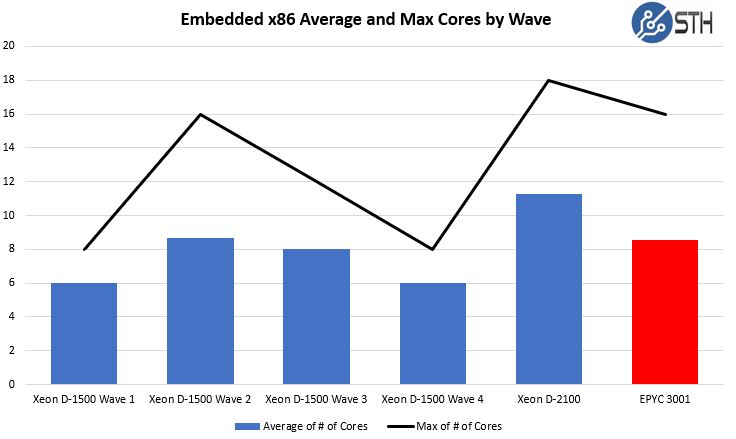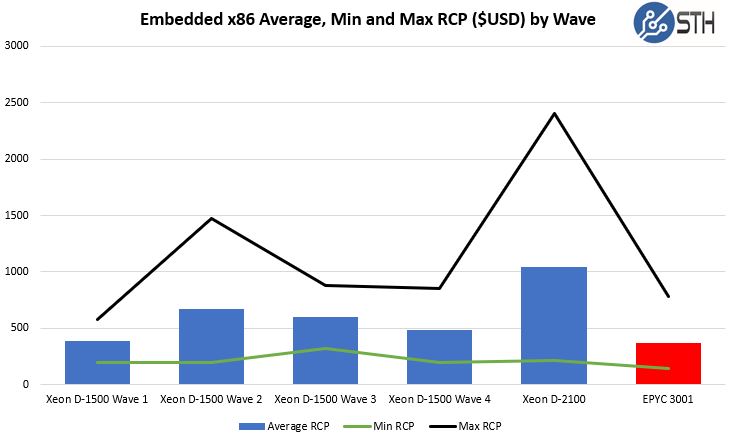AMD EPYC 3351 Market Positioning
Thes chips are not released in a vacuum instead, they have competition on both the Intel and AMD sides.
AMD EPYC 3351 v. Intel Alternatives
We did a longer discussion of the AMD EPYC 3001 series to Xeon D-1500 and D-2100 series in the Market Positioning section of our AMD EPYC 3451 Benchmarks and Review article. We still wanted to share a few charts from that article to show AMD’s market positioning.

AMD is targeting the higher-end of the Intel Xeon D-1500 spectrum with its line and the EPYC 3351. It is not targeting the lower-end Atom C3000 series. The overlap is not just in the D-1500 series but also clearly in the Xeon D-2100 series as AMD has competitive performance, and more memory and PCIe I/O than the D-2100 series.

Where AMD is differentiating is really in price. AMD is on a completely different level of list pricing than Intel. While we see Intel extracting steep premiums for higher core count parts, AMD is keeping its range between $38-$50/ core for models with 2-way SMT which is a tight range when we look at processor families even beyond the embedded space.
AMD EPYC 3351 v. AMD Alternatives
Here is what the AMD EPYC 3351 looks like compared to the other SKUs in this family:

As you can see, it has the full I/O of the EPYC 3001 series platform and the second-highest core count. That makes the value proposition straightforward. If one needs I/O, memory capacity, and CPU performance beyond the 8-core EPYC 3251 yet not at the 16-core EPYC 3451, then this is the chip to get.
The AMD EPYC 3351 is very interesting for another reason. As a $539 part, it is only $44.92 per core which is in line with other offerings in the stack:

Given the relatively tight price per core range moving from the EPYC 3251 and upward, we think that the biggest question comes down to the I/O needed. If one simply needs minimal I/O then the single-die SKUs likely make more sense. Getting full SR4 platform capabilities means that one needs to move to the EPYC 3351.
As a result, we think that the biggest decision within the AMD portfolio comes down to the right form factor, TDP, core count and I/O mix rather than metrics such as cost per core premiums that are common in our other market positioning discussions.
Final Words
We think this can be an extremely successful SKU. It adds more core count and memory bandwidth to the market with a relatively small premium over the 4-8 core single die line. Indeed, we expect many of our readers will be tanalized by systems built around the EPYC 3351.
The big drawback of this design is that it is a dual-die design which means we have two NUMA nodes. The market is very familiar with two NUMA node designs since it is conceptually similar to a dual-socket server. If scaling to twice the I/O and 12-cores means one can consolidate edge machines on a 2:1 or even a 3:2 ratio, then this trade-off is easily worth it since going over a network to another node is a more costly and lower-performance option.
As much as the 16-core EPYC 3451 is intriguing as a halo product, the EPYC 3351 we see as something different. The AMD EPYC 3351 has an exceptional mix of memory, 10GbE networking, and PCIe I/O to go along with its high-core count for the embedded market. Moving from 8 to 12 cores is always interesting, but moving from 32 to 64 PCIe lanes and twice the DDR4 channels is even more exciting.
Now the waiting game happens. There are some embedded COM Express Type 7 modules and similar more industrial applications that are already announced. We are eagerly awaiting seeing these chips make their way to more standardized platforms so that our readers have more deployment flexibility.




In the test config , shouldn’t the 3351 have only 12 cores?
Can someone just make that exact board. Double stack the SFP+ cages and add a BMC for oob management?
Is this a commercially available board? It looks awesome
> These are $539 list price parts.
hmm. list price for what? for epyc cpu the list price was $450
also, what is the name of this board? what is being tested here?
Andres/alt: this is AMD Wallaby platform as mentioned in the text. I guess it is not commercially available if you do not like over-priced engineering boards made by/for SoC vendor to show stuff to its customers (which are other hardware vendors). Just wait for common vendors (Kontron/Advantech/Supermicro etc.) to add this into their portfolio.
I think I am with Nate77 and alt. Let’s have a commercially available board and let it have 8 10 gig Ethernet ports.
Testing an AMD demo board is all very nice, but XEON D is on the shelves NOW.
alt – that is the 1K list price AMD sent as of a few weeks ago for the EPYC 3351 SoC.
Also, yes, this was done on the Wallaby development platform.
There reviews are always interesting. The embedded AMD parts are making me want to replace my home lab… but it doesn’t seem there are any groups selling them. SuperMicro only has lower end ones. It would be great if as part of these reviews you could reach out to OEMs to see what their ETA for availability is.
@Nate77 @emerth – do you think a software solutions can saturate 8 10 Gbit links, while doing something meaningful?
If so, please include some benchmark data.
So where can we buy this???